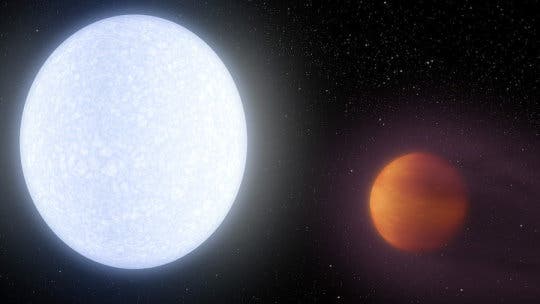A team has now found evidence of iron and titanium vapors in the atmosphere of the hottest planet ever discovered.

Planets don’t really get much hotter than KELT-9b. With a surface temperature well over 4,000 ℃, the planet was detected in 2017 using the Kilodegree Extremely Little Telescope, and the unusual finding raised quite a few eyebrows at the time.
KELT-9, the star around which the planet revolves, is located some 650 light years from Earth, in the constellation Cygnus (the Swan). It’s twice as hot as the Sun, but that’s not the reason why planet KELT-9b is so hot.
The reason is the orbiting distance: located 30 times closer than the Earth’s distance from the Sun, the planet revolves around its star in only 36 hours. As a result, temperatures reach 4,600° Kelvin (4,300 °C / 7,800 °F). That’s not quite as hot as the Sun, but it’s definitely hotter than many stars.

Astronomers aren’t really sure what the planet’s atmosphere might look like. Initial observations revealed that the atmosphere mostly comprises of hydrogen, but now, a new study has revealed some of its less abundant elements. Theoretical models suggested that metallic elements might be present in its atmosphere.
“The results of these simulations show that most of the molecules found there should be in atomic form because the bonds that hold them together are broken by collisions between particles that occur at these extremely high temperatures,” explains Kevin Heng, professor at the University of Bern.
Now, using the HARPS-North spectrograph, astronomers discovered a strong signal corresponding to iron vapor in the planet’s spectrum. They also found evidence of titanium in vapor form.
“With the theoretical predictions in hand, it was like following a treasure map,” says Jens Hoeijmakers, a researcher at the Universities of Geneva and Bern and lead author of the study, “and when we dug deeper into the data, we found even more,” he adds with a smile. Indeed, the team also detected the signature of another metal in vapur form: titanium.
This newly discovered planet might force scientists to open up a new planetary category: so-called “ultra-hot Jupiters.” Hot Jupiters are a class of gas giant exoplanets that are generally similar to Jupiter, but orbit much closer to their star — and are therefore much hotter. Ultra-hot Jupiters are even closer to their star
KELT-9b might not be the only planet to boast such an atmospheric composition. However, astronomers believe that planets like it, orbiting so close to their star, may be obliterated by the hellish environment in the star’s proximity. KELT-9b seems massive enough to take the pummeling, but others may have not been so fortunate.
Journal Reference: Hoeijmakers et al. Atomic iron and titanium in the atmosphere of the exoplanet KELT-9b. Nature, 2018; DOI: 10.1038/s41586-018-0401-y






